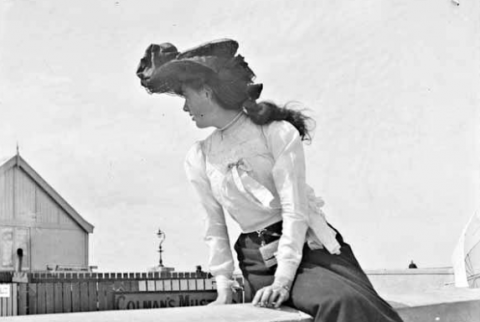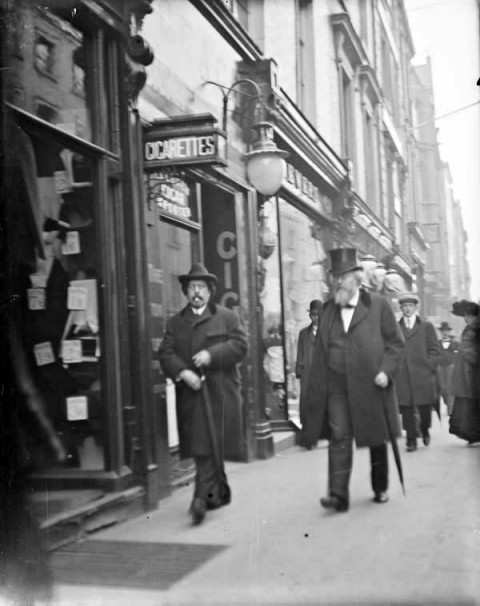The Google Cultural Institute has drawn our attention before, with its virtual exhibitions on the rise of the Eiffel Tower, the fall of the Iron Curtain, and many other notable chapters of human history. Today, take a look at a Google Cultural Institute gallery that has a foot in literature as well as in history, Dubliners: the Photographs of J.J. Clarke from the National Library of Ireland. Subtitled “a glimpse of James Joyce’s Dublin,” the online show presents pictures taken by this fellow Clarke at the turn of the 20th century, when he came to the Irish capital to study medicine. His “photojournalistic approach to his subjects allowed him to capture vivid scenes from the daily lives of Dublin’s men, women and children.”
This made Clarke a contemporary of Joyce, and so his “images also show us how the city looked” to the writer “whose best known works — the short story collection Dubliners, and the novels A Portrait of the Artist as a Young Man and Ulysses — are all set around that time, when Joyce too was a young student fascinated by the world around him.”
Both the photographer and the novelist, in their separate forms, set about capturing the city, the era, and the culture around them, and the pictures of Clarke’s featured at the Google Cultural Institute could easily illustrate any of Joyce’s books.
I’ve long enjoyed repeating the observation that, had the real Dublin crumbled, we could rebuild it from the details given in Ulysses — or at least we could rebuild the Dublin of 1904. But I now accept that having on hand Clarke’s photographs, about which you can learn much more at the National Library of Ireland’s site, they would greatly speed the reconstruction process as well. All of the Joycean texts mentioned above can be found in our collection of Free Audio Books and Free eBooks.
Related Content:
Vladimir Nabokov Creates a Hand-Drawn Map of James Joyce’s Ulysses
James Joyce, With His Eyesight Failing, Draws a Sketch of Leopold Bloom (1926)
James Joyce Reads ‘Anna Livia Plurabelle’ from Finnegans Wake
Colin Marshall hosts and produces Notebook on Cities and Culture and writes essays on literature, film, cities, Asia, and aesthetics. He’s at work on a book about Los Angeles, A Los Angeles Primer. Follow him on Twitter at @colinmarshall.





loved that period… men wore hats, people dressed up
Hated the corsets!
perhaps the *women* hated corsets, but then, if that is true, why are they still so prominent in the La Senza adverts?nnThen again, considering how the twenties’ flappers turned out, I expect the men weren’t really complaining. (Is that why they called them ‘flappers’? Just askin’
as lovely to look at shapely too are corsets, be bound by one & instantly you too nwould rather a flapper be LOL
as lovely to look at shapely too are corsets, be bound by one & instantly you too nwould rather a flapper be LOL
Dr Cooper not withstanding, I believe it had more to do with dance than physiognomy! nnThe period between the World Wars was a time of social, class, and sexual upheaval.nOther than that, have you ever worn a lace up corset? Let me tell you they are not for the faint of heart! Wore one in a play and — just saying!
“Had the real Dublin crumbled . . “? Unfortunately in a very substantial sense the real Dublin has crumbled. Only a short hop to the An Taisce offices or The Georgian Society website will show you the extent of it. Though it is local mess, it continues to shape the nation’s image of itself. This is tragic for there are good many people here but the prevailing political ethos is is far below this country’s best. Remember the thousands that demonstrated against the Wood Quay development? The peculiar pandering to the lowest common denominator encapsulated so well in the “sure, it’ll do” mentality does no one any favours here. The Irish who remember the Dublin of the 40ties are few in number and for the most part no longer care. In so man ways Ireland is an extraordinary country but as a community it lacks a sense that it is self governing and that for all it’s woes no one else is to blame. The annihilation of the Irish railway network or the destruction of Georgian Dublin are but two examples of how hell bent this country was on remaking itself. Unfortunately it went about self definition the Taliban way. But cultural identity and a sense of self comes from accepting one’s past, from it’s ownership, and the built environment is the very fabric in a very concrete form of that shared symbolic order, to use Peter Fuller’s phrase.nnThe pride and spiritual pay off that comes from the care and reconstruction of the past — what the Poles have done in Warsaw for example — is invaluable. The rebuilding of national heritage, much of which was destroyed by acts of ideological vengeance, would help in no small measure to heal the common psyche, the collective unconscious if you will, and allow the Irish to own their past.nnOn a practical level, this policy would also re-invigorate the craftsmen artisan culture and be a boon to the tourist industry, needles to say. Again, the rebuilding of the Warsaw castle is a case in point.
Pre-Boom Dublin in amazing high resolution photographs — never seen before:
http://www.photographyblogger.net/dublins-inner-city-reconstructed-through-photography-by-david-jazay/
If I had a message for the Irish people, it is cherish your heritage, even if it was built by the British. We Brits cherish our Roman heritage, and what is left of the Viking raids. It may have been unwelcome at the time, but it is our history.
Do not destroy something because it is not “Irish”, ask only if it adds or detracts from its environment.….
Wow!! Lovely nice photographs…really stunning..
Wow! Very interesting photographs…
Awesome! Really very nice photographs.…
Wow! Lovely !!! Really beautiful captures.
Nice photographs that gave me some fresh feelings.
Thank you so much to sharing this lovely photography. Brilliant capture. Nice place.
Hi,
I just wanted to say thanks. Really nice & excellent photographs.
Such an nice captures. Thanks For Sharing this great post with us.
Such a wonderful captures…
Love this photograph style. Really nice captures.
This capture is very wonderful! Love this post!
Really awesome pictures. I like all..
Wow!! Awesome pictures..really stunning..